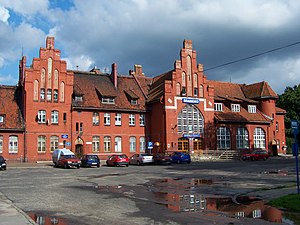S5 (Berlin)
| Prussian Eastern Railway | |
|---|---|

Braniewo (formerly Braunsberg) station on Russian-Polish border
|
|
| Overview | |
| Native name | Preußische Ostbahn |
| Locale | Kingdom of Prussia |
| Termini | Berlin Tschernyschewskoje |
| Line number |
|
| Technical | |
| Line length | 724.3 km (450.1 mi) |
| Track gauge |
|
| Electrification | |
| Operating speed | 100km/h (max) |
| Route number |
|
The Prussian Eastern Railway (German: Preußische Ostbahn) was the railway in the eastern Kingdom of Prussia until 1918. Its main route, approximately 740 kilometers (460 mi) long, connected the capital, Berlin with the cities of Danzig (Gdańsk) and Königsberg (Kaliningrad). At Eydtkuhnen (Chernyshevskoye) it reached the German Empire's border with the Russian Empire. The first part of the line opened in 1851, reaching Eydtkuhnen in 1860. By March 1880 the total route length reached 2,210 kilometers (1,370 mi), with a main parallel route in the south via Bromberg (Bydgoszcz) and Thorn (Toruń) to Insterburg (Chernyakhovsk). The lines were the first part of the later Prussian State Railways (German: Preußische Staatseisenbahnen).
From about 1840, the Prussian military urgently sought a railway connection to the Russian border for strategic reasons. The railway was also seen from the early years as a means of developing the underdeveloped areas of East Prussia and Pomerania. A lack of interest from the private sector led King Frederick William IV to initiate in 1845 preparatory work for the construction of the Eastern Railway. Construction was stopped, as the members of the provincial diet (Provinziallandtag) of East Prussia refused consent for the king to borrow for the project. This vote was confirmed in the United Diet (Vereinigter Landtag), the first parliamentary body covering all of Prussia, which was convened in April 1847 and subsequently dissolved. Members voted by a two-thirds majority against authorising a government loan for the Eastern Railway project.
...
Wikipedia
